Page 41 of 90
OPERATION AND IMPORTANT RIDING POINTS
5-4
2
3
4
56
7
8
9
EAU17212
Parking
When parking, stop the engine, and
then remove the key from the main
switch.
WARNING
EWA10310
�
Since the engine and exhaust
system can become very hot,
park in a place where pedestri-
ans or children are not likely to
touch them.
�
Do not park on a slope or on soft
ground, otherwise the vehicle
may overturn.
CAUTION:
ECA10380
Never park in an area where there
are fire hazards such as grass or
other flammable materials.
Page 42 of 90

6-1
1
2
3
4
5
6
7
8
9
PERIODIC MAINTENANCE AND MINOR REPAIR
EAU17240
Safety is an obligation of the owner. Pe-
riodic inspection, adjustment and lubri-
cation will keep your vehicle in the
safest and most efficient condition pos-
sible. The most important points of in-
spection, adjustment, and lubrication
are explained on the following pages.
The intervals given in the periodic
maintenance and lubrication chart
should be simply considered as a gen-
eral guide under normal riding condi-
tions. However, DEPENDING ON THE
WEATHER, TERRAIN, GEOGRAPHI-
CAL LOCATION, AND INDIVIDUAL
USE, THE MAINTENANCE INTER-
VALS MAY NEED TO BE SHORT-
ENED.
WARNING
EWA10320
If you are not familiar with mainte-
nance work, have a Yamaha dealer
do it for you.
EAU17520
Owner’s tool kit
The owner’s tool kit is located inside the
storage compartment under the seat.
(See page 3-14.)
The service information included in this
manual and the tools provided in the
owner’s tool kit are intended to assist
you in the performance of preventive
maintenance and minor repairs. How-
ever, additional tools such as a torque
wrench may be necessary to perform
certain maintenance work correctly.
NOTE:
If you do not have the tools or experi-
ence required for a particular job, have
a Yamaha dealer perform it for you.
WARNING
EWA10350
Modifications not approved by
Yamaha may cause loss of perfor-
mance and render the vehicle un-
safe for use. Consult a Yamaha
dealer before attempting any chang-
es.
1. Owner’s tool kit
1
Page 49 of 90
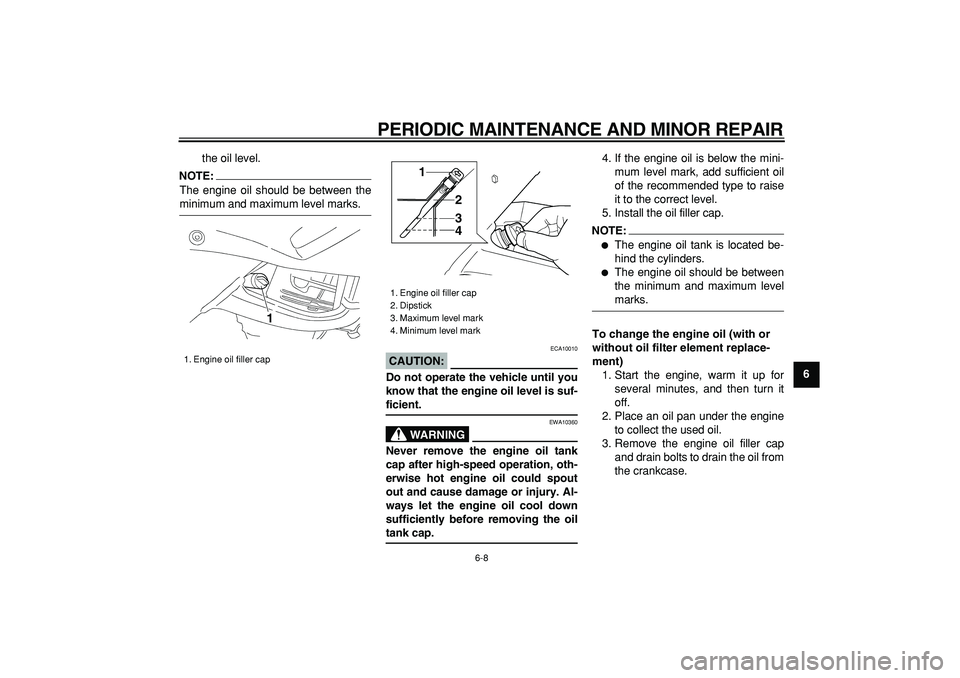
PERIODIC MAINTENANCE AND MINOR REPAIR
6-8
2
3
4
5
67
8
9
the oil level.
NOTE:
The engine oil should be between the
minimum and maximum level marks.
CAUTION:
ECA10010
Do not operate the vehicle until you
know that the engine oil level is suf-
ficient.
WARNING
EWA10360
Never remove the engine oil tank
cap after high-speed operation, oth-
erwise hot engine oil could spout
out and cause damage or injury. Al-
ways let the engine oil cool down
sufficiently before removing the oil
tank cap.
4. If the engine oil is below the mini-
mum level mark, add sufficient oil
of the recommended type to raise
it to the correct level.
5. Install the oil filler cap.
NOTE:
�
The engine oil tank is located be-
hind the cylinders.
�
The engine oil should be between
the minimum and maximum level
marks.
To change the engine oil (with or
without oil filter element replace-
ment)
1. Start the engine, warm it up for
several minutes, and then turn it
off.
2. Place an oil pan under the engine
to collect the used oil.
3. Remove the engine oil filler cap
and drain bolts to drain the oil from
the crankcase.
1. Engine oil filler cap
1
1. Engine oil filler cap
2. Dipstick
3. Maximum level mark
4. Minimum level mark
1
2
3
4
Page 52 of 90

PERIODIC MAINTENANCE AND MINOR REPAIR
6-11
1
2
3
4
5
6
7
8
9
3. If the coolant is at or below the
minimum level mark, remove pan-
el A (See page 6-5.), remove the
reservoir cap, add coolant to the
maximum level mark, and then in-
stall the reservoir cap and the pan-
el.
CAUTION:
ECA10471
�
If coolant is not available, use
distilled water or soft tap water
instead. Do not use hard water
or salt water since it is harmful
to the engine.
�
If water has been used instead
of coolant, replace it with cool-
ant as soon as possible, other-
wise the cooling system will not
be protected against frost and
corrosion.
�
If water has been added to thecoolant, have a Yamaha dealer
check the antifreeze content of
the coolant as soon as possible,
otherwise the effectiveness of
the coolant will be reduced.
WARNING
EWA10380
Never attempt to remove the radiator
cap when the engine is hot.
NOTE:
�
The radiator fan is automatically
switched on or off according to the
coolant temperature in the radia-
tor.
�
If the engine overheats, see page
6-34 for further instructions.
1. Maximum level mark
2. Coolant reservoir
3. Minimum level mark
3 1
2
1. Coolant reservoir cap
Coolant reservoir capacity (up to the
maximum level mark):
0.25 L (0.26 US qt) (0.22 Imp.qt)
1
Page 53 of 90
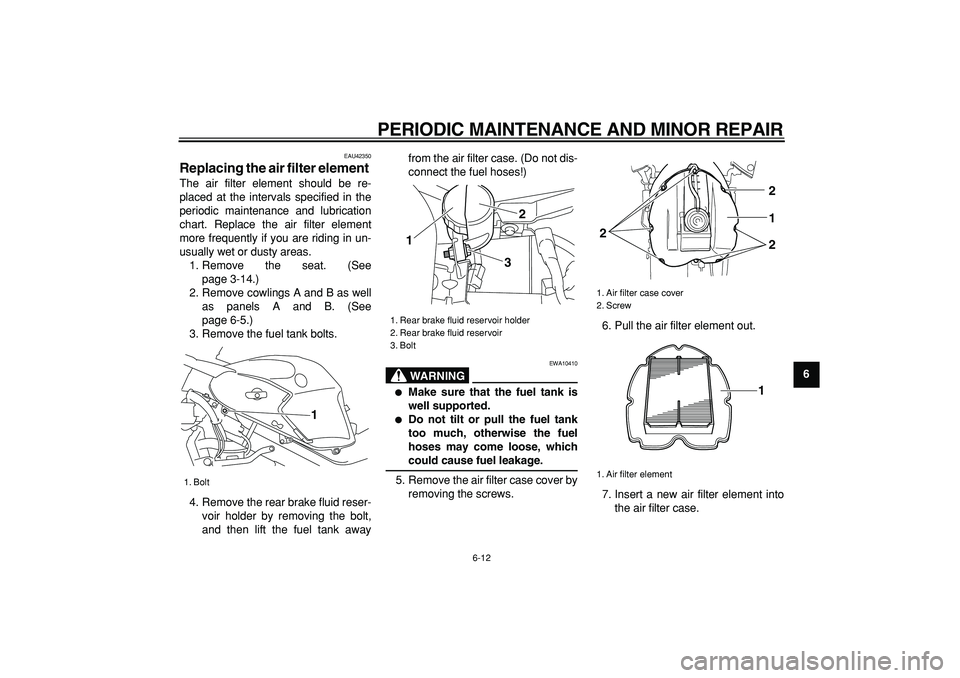
PERIODIC MAINTENANCE AND MINOR REPAIR
6-12
2
3
4
5
67
8
9
EAU42350
Replacing the air filter element
The air filter element should be re-
placed at the intervals specified in the
periodic maintenance and lubrication
chart. Replace the air filter element
more frequently if you are riding in un-
usually wet or dusty areas.
1. Remove the seat. (See
page 3-14.)
2. Remove cowlings A and B as well
as panels A and B. (See
page 6-5.)
3. Remove the fuel tank bolts.
4. Remove the rear brake fluid reser-
voir holder by removing the bolt,
and then lift the fuel tank awayfrom the air filter case. (Do not dis-
connect the fuel hoses!)
WARNING
EWA10410
�
Make sure that the fuel tank is
well supported.
�
Do not tilt or pull the fuel tank
too much, otherwise the fuel
hoses may come loose, which
could cause fuel leakage.
5. Remove the air filter case cover by
removing the screws.6. Pull the air filter element out.
7. Insert a new air filter element into
the air filter case.
1. Bolt
1
1. Rear brake fluid reservoir holder
2. Rear brake fluid reservoir
3. Bolt
12
3
1. Air filter case cover
2. Screw
1. Air filter element
1 2
2 21
Page 54 of 90
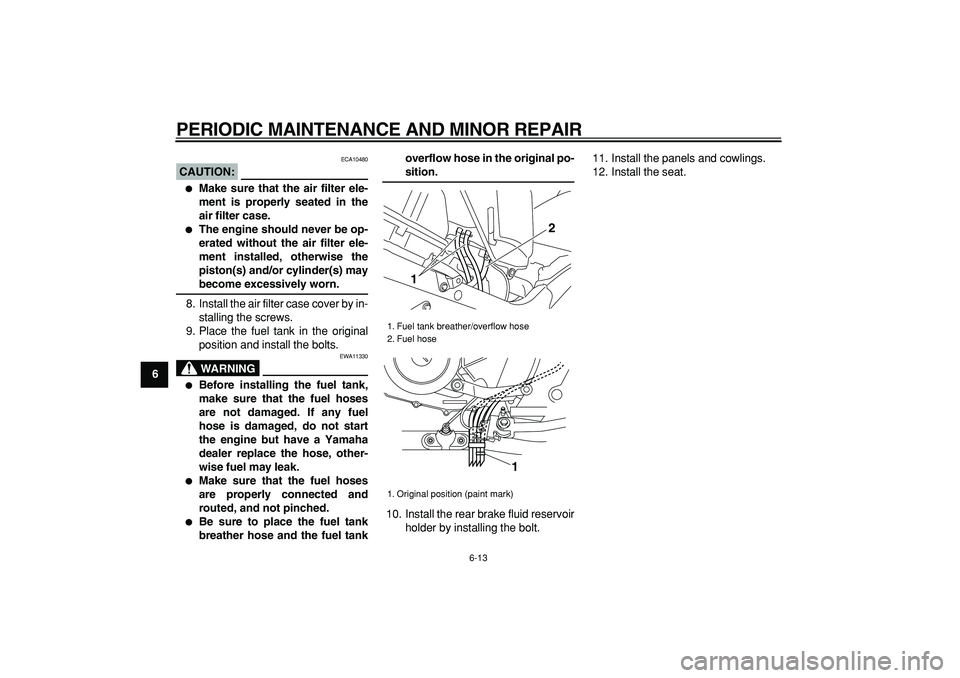
PERIODIC MAINTENANCE AND MINOR REPAIR
6-13
1
2
3
4
5
6
7
8
9
CAUTION:
ECA10480
�
Make sure that the air filter ele-
ment is properly seated in the
air filter case.
�
The engine should never be op-
erated without the air filter ele-
ment installed, otherwise the
piston(s) and/or cylinder(s) may
become excessively worn.
8. Install the air filter case cover by in-
stalling the screws.
9. Place the fuel tank in the original
position and install the bolts.
WARNING
EWA11330
�
Before installing the fuel tank,
make sure that the fuel hoses
are not damaged. If any fuel
hose is damaged, do not start
the engine but have a Yamaha
dealer replace the hose, other-
wise fuel may leak.
�
Make sure that the fuel hoses
are properly connected and
routed, and not pinched.
�
Be sure to place the fuel tank
breather hose and the fuel tankoverflow hose in the original po-
sition.
10. Install the rear brake fluid reservoir
holder by installing the bolt.11. Install the panels and cowlings.
12. Install the seat.
1. Fuel tank breather/overflow hose
2. Fuel hose
1. Original position (paint mark)
12
1
Page 56 of 90
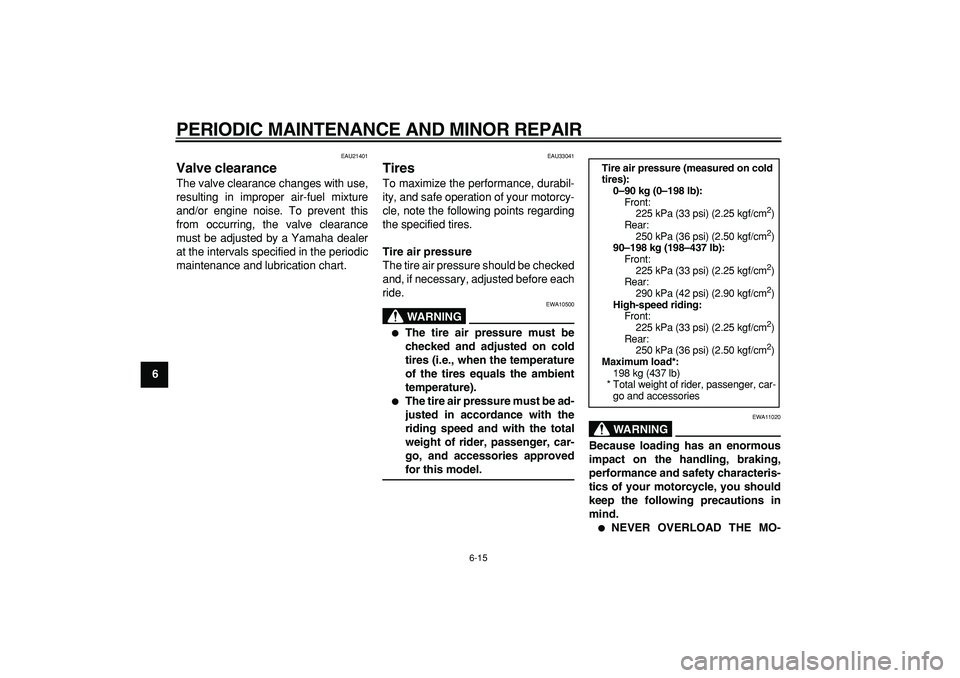
PERIODIC MAINTENANCE AND MINOR REPAIR
6-15
1
2
3
4
5
6
7
8
9
EAU21401
Valve clearance
The valve clearance changes with use,
resulting in improper air-fuel mixture
and/or engine noise. To prevent this
from occurring, the valve clearance
must be adjusted by a Yamaha dealer
at the intervals specified in the periodic
maintenance and lubrication chart.
EAU33041
Tires
To maximize the performance, durabil-
ity, and safe operation of your motorcy-
cle, note the following points regarding
the specified tires.
Tire air pressure
The tire air pressure should be checked
and, if necessary, adjusted before each
ride.
WARNING
EWA10500
�
The tire air pressure must be
checked and adjusted on cold
tires (i.e., when the temperature
of the tires equals the ambient
temperature).
�
The tire air pressure must be ad-
justed in accordance with the
riding speed and with the total
weight of rider, passenger, car-
go, and accessories approved
for this model.
WARNING
EWA11020
Because loading has an enormous
impact on the handling, braking,
performance and safety characteris-
tics of your motorcycle, you should
keep the following precautions in
mind.
�
NEVER OVERLOAD THE MO-
Tire air pressure (measured on cold
tires):
0–90 kg (0–198 lb):
Front:
225 kPa (33 psi) (2.25 kgf/cm
2
)
Rear:
250 kPa (36 psi) (2.50 kgf/cm
2
)
90–198 kg (198–437 lb):
Front:
225 kPa (33 psi) (2.25 kgf/cm
2
)
Rear:
290 kPa (42 psi) (2.90 kgf/cm
2
)
High-speed riding:
Front:
225 kPa (33 psi) (2.25 kgf/cm
2
)
Rear:
250 kPa (36 psi) (2.50 kgf/cm
2
)
Maximum load*:
198 kg (437 lb)
* Total weight of rider, passenger, car-
go and accessories
Page 57 of 90
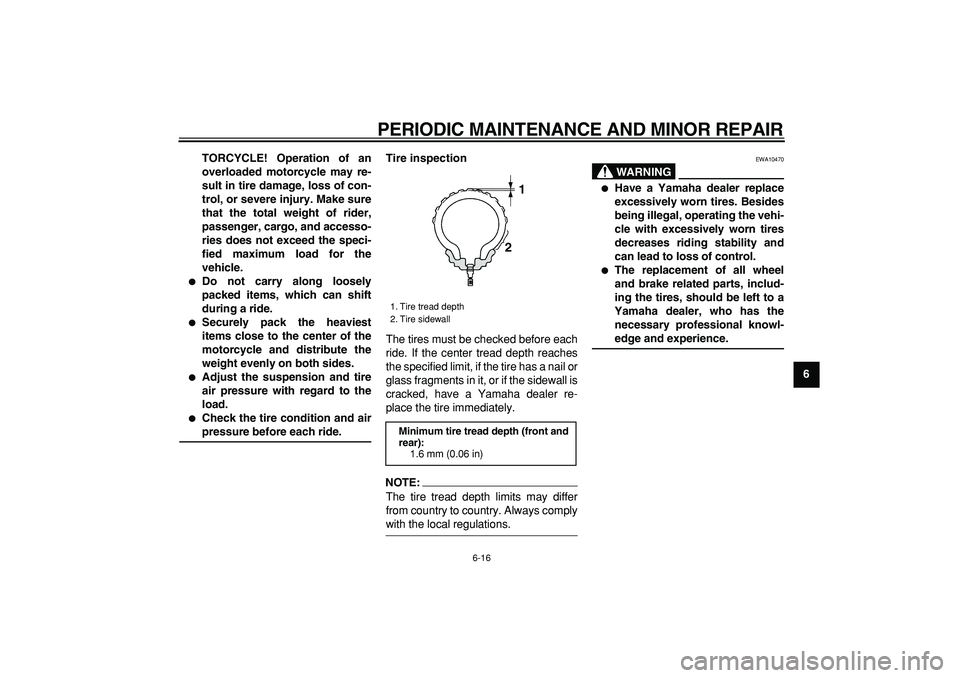
PERIODIC MAINTENANCE AND MINOR REPAIR
6-16
2
3
4
5
67
8
9 TORCYCLE! Operation of an
overloaded motorcycle may re-
sult in tire damage, loss of con-
trol, or severe injury. Make sure
that the total weight of rider,
passenger, cargo, and accesso-
ries does not exceed the speci-
fied maximum load for the
vehicle.
�
Do not carry along loosely
packed items, which can shift
during a ride.
�
Securely pack the heaviest
items close to the center of the
motorcycle and distribute the
weight evenly on both sides.
�
Adjust the suspension and tire
air pressure with regard to the
load.
�
Check the tire condition and air
pressure before each ride.Tire inspection
The tires must be checked before each
ride. If the center tread depth reaches
the specified limit, if the tire has a nail or
glass fragments in it, or if the sidewall is
cracked, have a Yamaha dealer re-
place the tire immediately.
NOTE:
The tire tread depth limits may differ
from country to country. Always comply
with the local regulations.
WARNING
EWA10470
�
Have a Yamaha dealer replace
excessively worn tires. Besides
being illegal, operating the vehi-
cle with excessively worn tires
decreases riding stability and
can lead to loss of control.
�
The replacement of all wheel
and brake related parts, includ-
ing the tires, should be left to a
Yamaha dealer, who has the
necessary professional knowl-
edge and experience.
1. Tire tread depth
2. Tire sidewall
Minimum tire tread depth (front and
rear):
1.6 mm (0.06 in)
21